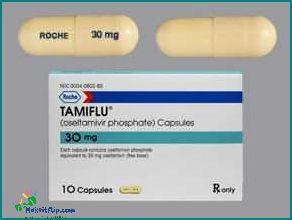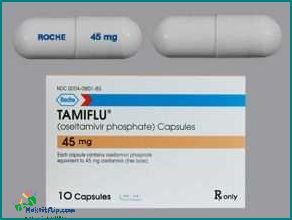Contents
A Comprehensive Guide to the Uses and Interactions of Tamiflu and Tylenol: Everything You Need to Know

When it comes to managing pain and symptoms caused by a virus, such as a headache or cold, two commonly used medications are Tamiflu and Tylenol. Tamiflu is an antiviral medication that is often prescribed to treat the flu, while Tylenol is a popular over-the-counter pain reliever and fever reducer. Understanding the uses and interactions of these medications can help individuals make informed decisions about their health.
Tylenol, also known by its generic name acetaminophen, is commonly used to relieve pain and reduce fever. It is effective in treating minor aches and pains associated with headaches, muscle aches, and cold symptoms. Tylenol works by blocking certain chemicals in the body that cause pain and fever. It is important to follow the recommended dosage and not exceed the maximum daily limit to avoid potential liver damage.
Tamiflu, on the other hand, is specifically designed to treat the flu caused by the influenza virus. It works by inhibiting the growth and spread of the virus in the body. Tamiflu is most effective when taken within 48 hours of experiencing flu symptoms. It can help reduce the duration and severity of flu symptoms, such as fever, cough, and body aches. It is important to note that Tamiflu is a prescription medication and should only be taken under the guidance of a healthcare professional.
While both Tamiflu and Tylenol can be effective in managing symptoms, it is important to be aware of their potential interactions. Tylenol can be safely taken with Tamiflu, as they work in different ways to target different symptoms. However, it is always recommended to consult with a healthcare professional before taking any medications, especially if you have any underlying health conditions or are taking other medications.
In conclusion, Tamiflu and Tylenol are both commonly used medications for managing pain, fever, and flu symptoms. Tylenol is an over-the-counter pain reliever and fever reducer, while Tamiflu is a prescription antiviral medication specifically designed to treat the flu. Understanding their uses and potential interactions can help individuals make informed decisions about their health. It is always best to consult with a healthcare professional before starting any new medication.
Section 1: Understanding Tamiflu

Tamiflu is a medication that is commonly used to treat influenza, also known as the flu. It is an antiviral drug that works by inhibiting the growth and spread of the influenza virus in the body.
One of the main symptoms of the flu is fever, which can be accompanied by body aches, headache, and fatigue. Tamiflu is often prescribed to help reduce these symptoms and shorten the duration of the illness.
In addition to treating the flu, Tamiflu can also be used as a preventive measure for individuals who have been exposed to the virus. It is important to note that Tamiflu is most effective when taken within 48 hours of the onset of symptoms.
While Tamiflu is effective in treating the flu, it is not a cure. It is important to rest, stay hydrated, and take other measures to alleviate symptoms such as using over-the-counter pain relievers like Tylenol for fever and pain.
Tylenol, also known as acetaminophen, is a common medication used to relieve pain and reduce fever. It can be used in conjunction with Tamiflu to help manage symptoms of the flu, such as headache and body aches.
It is important to consult with a healthcare professional before taking Tamiflu or Tylenol, especially if you have any underlying medical conditions or are taking other medications. They can provide guidance on the appropriate dosage and any potential interactions.
| Tamiflu | Tylenol |
|---|---|
| Antiviral medication | Pain reliever and fever reducer |
| Treats influenza | Relieves pain and reduces fever |
| Reduces symptoms and duration of the flu | Alleviates headache and body aches |
| Can be used preventively |
In conclusion, Tamiflu is a medication commonly used to treat influenza, while Tylenol is a pain reliever and fever reducer. Both can be used together to manage symptoms of the flu, but it is important to consult with a healthcare professional for proper guidance.
What is Tamiflu?

Tamiflu is a medication used to treat and prevent influenza, commonly known as the flu. It is an antiviral drug that works by inhibiting the growth and spread of the flu virus in the body. Tamiflu is most effective when taken within 48 hours of the onset of flu symptoms.
Flu symptoms can include fever, cough, sore throat, runny or stuffy nose, body aches, headache, chills, and fatigue. Tamiflu can help reduce the severity and duration of these symptoms, as well as prevent complications such as pneumonia.
Tamiflu is available in capsule and liquid form, and it is typically taken twice a day for five days. It is important to follow the prescribed dosage and complete the full course of treatment, even if you start feeling better before the medication is finished.
It is worth noting that Tamiflu is not a pain reliever like Tylenol. While Tylenol can help alleviate symptoms such as fever, headache, and body aches, Tamiflu specifically targets the flu virus itself.
If you suspect you have the flu, it is recommended to consult with a healthcare professional to determine the best course of treatment. They can provide guidance on whether Tamiflu is appropriate for your specific situation and can also advise on the use of other medications, such as Tylenol, to manage symptoms.
How does Tamiflu work?

Tamiflu is a medication that is commonly used to treat the flu virus. It contains the active ingredient oseltamivir, which is classified as a neuraminidase inhibitor. Neuraminidase is an enzyme that is produced by the flu virus and is responsible for the release of new virus particles from infected cells.
When you have the flu, the virus attaches itself to your respiratory cells and begins to replicate. This can cause symptoms such as headache, fever, and body aches. Tamiflu works by inhibiting the neuraminidase enzyme, which prevents the release of new virus particles. By doing so, it helps to slow down the spread of the virus in your body.
By slowing down the spread of the flu virus, Tamiflu can help to reduce the severity and duration of flu symptoms. It can also help to prevent complications from the flu, such as pneumonia. However, it’s important to note that Tamiflu is not a cure for the flu and will not treat other viral infections, such as the common cold.
It’s also worth mentioning that Tamiflu is not a pain reliever like Tylenol. While Tylenol can help to reduce fever and relieve pain associated with the flu, Tamiflu specifically targets the flu virus itself. Therefore, it’s not a substitute for other cold or flu medications that may be needed to manage symptoms such as congestion or cough.
In summary, Tamiflu works by inhibiting the neuraminidase enzyme produced by the flu virus, which helps to slow down the spread of the virus in your body. It is not a pain reliever and should be used in conjunction with other medications as needed to manage flu symptoms.
Common uses of Tamiflu

Tamiflu is a medication that is commonly used to treat the flu virus. It is an antiviral drug that helps to reduce the severity and duration of flu symptoms. Tamiflu is most effective when taken within 48 hours of the onset of symptoms.
One of the common uses of Tamiflu is to relieve the pain and discomfort associated with the flu. It can help to reduce body aches, headache, and fever. Tamiflu works by inhibiting the growth and spread of the flu virus in the body.
When taken as directed, Tamiflu can help to shorten the duration of flu symptoms by about one to two days. It can also help to prevent complications from the flu, such as pneumonia, especially in high-risk individuals.
It is important to note that Tamiflu is not a substitute for the flu vaccine. The flu vaccine is the best way to prevent the flu, and Tamiflu should be used as a treatment option if you do get sick with the flu.
| Common uses of Tamiflu: |
|---|
| – Relieving pain and discomfort |
| – Reducing body aches, headache, and fever |
| – Shortening the duration of flu symptoms |
| – Preventing complications from the flu |
If you are experiencing flu-like symptoms, it is important to consult with a healthcare professional to determine the best course of treatment, which may include Tamiflu.
Section 2: Understanding Tylenol

Tylenol is a commonly used medication for relieving pain and reducing fever. It is especially effective in treating symptoms associated with the flu, such as headache and body aches. Tylenol contains the active ingredient acetaminophen, which works by blocking certain chemicals in the brain that cause pain and fever.
When you have the flu or a cold, Tylenol can help alleviate the discomfort caused by these illnesses. It can provide relief from symptoms like headache, muscle aches, and fever. Tylenol is available in various forms, including tablets, capsules, and liquid, making it easy to take and suitable for different age groups.
It is important to follow the recommended dosage instructions when taking Tylenol. Taking too much of this medication can lead to liver damage, so it is crucial to not exceed the maximum daily dose. If you are unsure about the appropriate dosage, consult your healthcare provider.
While Tylenol can provide temporary relief from flu symptoms, it does not treat the underlying cause of the illness. If you suspect you have the flu, it is important to consult a healthcare professional for an accurate diagnosis and appropriate treatment. In some cases, your healthcare provider may prescribe antiviral medications, such as Tamiflu, to help shorten the duration of the flu and reduce its severity.
In summary, Tylenol is a widely used medication for relieving pain and reducing fever associated with the flu and cold. It is important to use Tylenol as directed and consult a healthcare professional if you have any concerns or questions about its use.
FAQ about topic Tamiflu and Tylenol A Comprehensive Guide to Their Uses and Interactions
What is Tamiflu used for?
Tamiflu is used to treat and prevent influenza (flu) virus infections.
How does Tamiflu work?
Tamiflu works by inhibiting the growth and spread of the flu virus in the body.
What are the side effects of Tamiflu?
The common side effects of Tamiflu include nausea, vomiting, diarrhea, headache, and dizziness.
Can Tamiflu be taken with other medications?
Tamiflu can be taken with other medications, but it is important to consult a healthcare professional before doing so to avoid any potential drug interactions.
Is Tamiflu safe for pregnant women?
Tamiflu is generally considered safe for pregnant women, but it is recommended to discuss with a healthcare professional before taking it.
I’m Diana Ricciardi, the author behind Makeitflip.com. My blog is a dedicated space for mothers and their kids, where I share valuable insights, tips, and information to make parenting a bit easier and more enjoyable.
From finding the best booster seat high chair for your child, understanding the connection between sciatica and hip pain, to exploring the benefits of pooping in relieving acid reflux, I cover a range of topics that are essential for every parent.
My goal is to provide you with practical advice and solutions that you can easily incorporate into your daily life, ensuring that you and your child have the best possible experience during these precious years.
